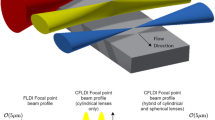Abstract
Experiments on the effect of trip geometry, size, and location on the position of transition at local Mach numbers up to 8.5 are presented. The pressure drag of the trip is investigated at local Mach numbers of 4.7 and 5.5. Based on test results, a flow model was constructed which includes trip-produced multiple vortex filaments similar to those found at supersonic speeds that are assumed to be responsible for introducing the disturbances that lead to transition. The Reynolds number based on the distance from the leading edge to the roughness position as well as Mach number and wall-to-total temperature ratio should be considered in choosing the smallest effective trip size. The effect of trip shape on the position of transition at hypersonic speeds is small; however, certain shapes exhibit the advantageous characteristic of having drag coefficients which were relatively independent of roughness height over a restricted range of the variables tested.
Access this chapter
Tax calculation will be finalised at checkout
Purchases are for personal use only
Preview
Unable to display preview. Download preview PDF.
Similar content being viewed by others
References
Westkaemper, J. C., “Turbulent boundary-layer separation ahead of cylinders,” AIAA Journal, Vol. 6, No. 7, 1352–1355 (July 1968).
Rainbird, W. J., Crabbe, R. S., Peake, D. J., and Meyer, Dr. R. F., “Some examples of separation in three-dimensional flows,” Canadian Aeronautics and Space Journal, Vol. 12, No. 10, (December 1966).
Hall, Gordon R., “Interaction of the wake from bluff bodies with an initially laminar boundary layer,” AIAA Third Aerospace Sciences Meeting, N.Y., N.Y., January 24–26, 1966, AIAA Paper No. 66–126.
Van Driest, E. R. and McCauley, W. D., “The effect of controlled three-dimensional roughness on boundary-layer transition at supersonic speeds,” Journal of the Aero/Space Sciences, 261–271 and 303 (April 1960).
Van Driest, E. R. and Blumer, C. B., “Summary report on studies on boundary layer transition for years 1963–64,” Space Sciences Laboratory, North American Aviation, Inc., SID 64 2191 (December 1964).
Klebanoff, P. S., Schubauer, G. B., and Tidstrom, K. D., “Measurements of the effect of two-dimensional and three-dimensional roughness elements on boundary-layer transition,” Readers’ Forum, National Bureau of Standards, Washington, D.C. (June 1955).
Sterrett, J.. R., Mbrrisette, E. L., Whitehead, A. H., Jr., and Hicks, R. M., “Transition fixing for hypersonic flow,” NASA TN D-4129 (October 1967).
Van Driest, E. R. and Blumer, C. B., “Boundary-layer transition at supersonic speeds - three-dimensional roughness effects (spheres),” Journal of Aero/Space Sciences, 909=916 (August 1962).
Korkegi, Robert H., “Transition studies and skin-friction measurements on an insulated flat plate at a Mach number of 5.8,” Journal of the Aeronautical Sciences; 97–107 and 192, (February 1956).
Holloway, Paul F. and Sterrett, James R., “Effect of controlled surface roughness on boundary-layer transition and heat transfer at Mach numbers of 4.8 and 6.0,” NASA TN D-2054, (April 1964).
Potter, J. L. and Whitfield, J. D., “Effects of unit Reynolds number, nose bluntness, and roughness on boundary layer transition,” AEDC-TR-60–5, (March 1960).
Potter, J. L. and Whitfield, J. D., “Effects of slight nose bluntness and roughness on boundary-layer transition in supersonic flows,” Journal Fluid Mech., Vol. 12, Pt. 4, 501–535, (1962).
Potter, J. L. and Whitfield,. J. D., “Boundary-layer transition under hypersonic conditions,” AGARDograph 97, Part III, “Recent developments in boundary layer research,” (May 1965).
Stainback, P. Calvin, “Some effects of roughness and variable entropy on transition at a Mach number of 8,” presented at the AIAA Fifth Aerospace Sciences Meeting, New York, New York, January 23–25, 1967.
Whitfield, J. D. and Iannuzzi, F. A., “Experiments on roughness effects on boundary-layer transition up to Mach 16,” AIAA Third Aerodynamic Testing Conference, San Francisco, California, April 8–10, 1968, AIAA Paper No. 68–377.
Torrence, Marvin G., “Concentration measurements of an injected gas in a supersonic stream,” NASA TN D-3860, (April 1967).
Price, E. A., Jr., and Stallings, R. L, Jr., “Investigation of turbulent separated flows in the vicinity of fin-type protuberances at supersonic Mach numbers,” NASA TN D-3804 (February 1967).
Braslow, Albert L., Hicks, Raymond M., and Harris, Roy V., Jr., “Use of grit-type boundary-layer-transition trips on wind-tunnel models,” NASA TN D-3579 (September 1966).
Monaghan, R. J., “An approximate solution of the compressible laminar boundary layer on a flat plate,” R.ZHAOHUANM. No. 2760, Brit. A.R.C., (1953).
Spalding, D. B. and Chi, S. W., “The drag of a compressible turbulent boundary layer on a smooth flat plate with and without heat transfer,” Journal Fluid Mech., Vol. 18, Pt. I, 117–143, (January 1964).
Bertram, Mitchel H, and Neal, Luther, Jr., “Recent experiments in hypersonic turbulent boundary layers,” Presented at the AGARD Specialists Meeting on Recent Developments in Boundary-Layer Research, Naples, Italy, (May 10–14, 1965 ).
McCauley, W. D., Saydah, A., and Bueche, J., “The effect of controlled three-dimensional roughness on hypersonic laminar boundary layer transition,” AIAA Paper No. 66–26, (January 1966).
Author information
Authors and Affiliations
Editor information
Editors and Affiliations
Rights and permissions
Copyright information
© 1969 Springer Science+Business Media New York
About this paper
Cite this paper
Morrisette, E.L., Stone, D.R., Whitehead, A.H. (1969). Boundary-Layer Tripping with Emphasis on Hypersonic Flows. In: Wells, C.S. (eds) Viscous Drag Reduction. Springer, Boston, MA. https://doi.org/10.1007/978-1-4899-5579-1_2
Download citation
DOI: https://doi.org/10.1007/978-1-4899-5579-1_2
Publisher Name: Springer, Boston, MA
Print ISBN: 978-1-4899-5581-4
Online ISBN: 978-1-4899-5579-1
eBook Packages: Springer Book Archive




